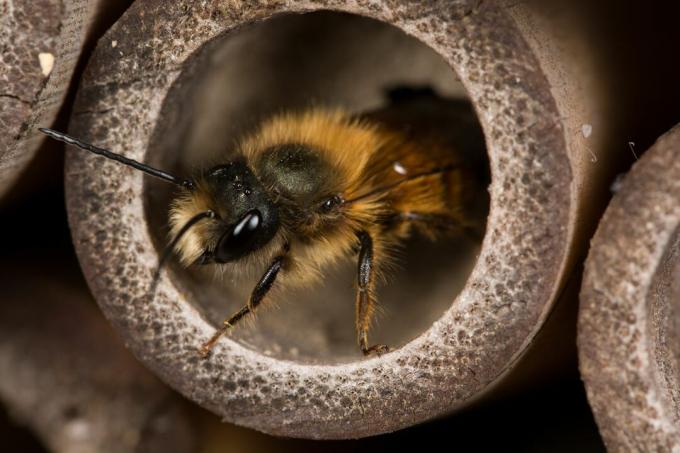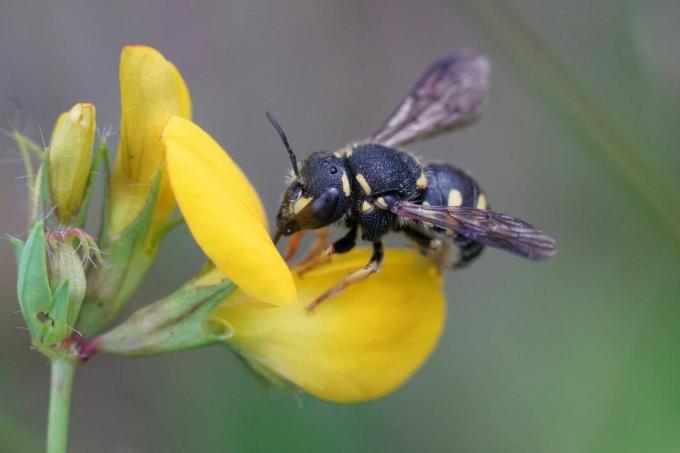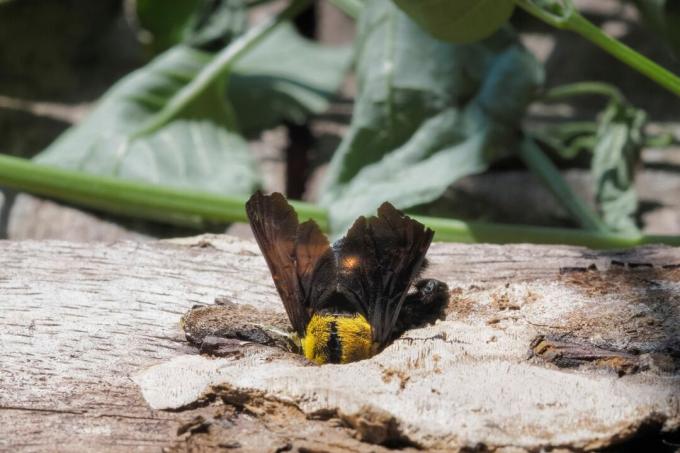Most people know honey bees, but what about wild bees? In fact, the inconspicuous wild bees are of great value to our nature.

The death of bees has been on everyone's lips for years. But when it comes to bees, many only think of the well-known honey bee - on the other hand, one rarely hears anything about wild bees. It is precisely the native wild bee species that are often particularly threatened. The reasons for this are varied and range from a decline in their habitat to insufficient food supply to the use of pesticides. But why are wild bees so important? And how can we support the threatened wild bee species? We'll tell you that in today's post.
contents
- Identifying wild bees: Which wild bee species are there?
-
Wild bee life cycle
- Where do wild bees live?
- How do wild bees live?
- How long do bees live?
-
Wild bee nests
- Where do wild bees nest in nature?
- When do wild bees nest?
- How do wild bees nest?
- How do wild bees build their nests?
- Do wild bees make honey?
- Can wild bees sting?
- Why are bees important in the garden?
-
Establish and support wild bees
- Create and maintain nesting opportunities
- Create food supply
- No spraying agents
Identifying wild bees: Which wild bee species are there?
What kind of insect is that actually? You have probably asked yourself this question before. In fact, it is not that easy to identify wild bees: just over 550 different wild bee species live in Germany alone. All bee species of the superfamily become wild bees Apoidea counted, except for the domesticated honeybees. This is why there are serious differences in appearance and size between the individual bees. The smallest wild bee (the sand steppe bee) is only 4 mm tall, while the blue wooden bee, the largest wild bee, reaches a stately 2.8 cm. Then how do I recognize wild bees? Despite their great variability, you can basically tell at some points whether it is a bee or another insect.
Identifying wild bees made easy:
- Bees have a tripartite body.
- Your head has two clearly visible, long antennae.
- The two pairs of wings of the bees are attached in the middle to the back and on the middle segment of the body. They consist of a transparent wing skin, which is criss-crossed with clearly visible veins.
- Bees often show light hairiness.
- Bees can be seen collecting pollen or nectar.

Wild bees and honey bees: It is often not that easy to tell whether you are looking at a wild bee or a honey bee. But if you look closely, you can see two differences between classic honeybees and wild bees: The workers of the Honey bees typically have protruding hairs on their large compound eyes - this only occurs with cone bees in wild bees before. In addition, the honey bee lacks the spur on the rail of its hind legs, which is always present in native wild bee species.

Wild bee life cycle
As different as the various wild bee species look, so are their ways of life. In addition to the classic forager bees that feed on nectar and pollen, there are also so-called Cuckoo bees that sneak into the nests of other species of bees and kill the offspring and them there Eat supplies. It is therefore not that easy to make general statements about the life cycle of wild bees. Nevertheless, we have put together and answered the most frequently asked questions on the topic.
Where do wild bees live?
Wild bees belong to the most species-rich groups in the insect kingdom and are distributed almost worldwide. Numerous native wild bee species are also at home in Germany. The habitat of wild bees can look very different: In addition to richly structured forest edges, Orchards and grassland, some wild bees also use dry stone walls, demolition and steep edges or the edges of water Habitat. Many native wild bee species are highly specialized, so that they can only be found in habitats with special properties.

Tip: Wild bees particularly like to settle near a suitable food supply. Therefore, creating a wildflower meadow is a good first step in promoting the fascinating insects. For example, you can create a varied and long-flowering meadow with our Plantura beneficial insect magnetthat contains over 20 different, knee-high flowers.
How do wild bees live?
Generally valid statements about the way of life of wild bees are difficult to make, because there are actually four different ways of life in wild bees. Solitary bees, also known as hermit bees, build their nests without the help of conspecifics and also care for their brood on their own. Each nest therefore houses only one female who takes care of the 4 - 30 brood cells on her own. Social bees, on the other hand, are more reminiscent of the classic way of life of honey bees, as many are familiar with. Here the bees live together in communities and are closely related to one another. Depending on the wild bee species, these communities can have a few bees or several thousand individuals and have a differently strict hierarchy. The communal wild bees are located in the middle between the solitary and social bees. Here two or more females of the same generation often live together in one nest, but only care for their own brood cells. The last way of life are the cuckoo bees mentioned earlier - they nest in the nests of strange bees and steal the supplies there.

How long do bees live?
Most of the native wild bee species in Germany are so-called univolent species. That means there is only one generation per year. The adult bees often only live for about four to six weeks - they use this time for reproduction and the creation of brood cells with the necessary food supply for their offspring. The larvae of the wild bees then hibernate well protected in their nest, where they hatch as adults in the next spring and reproduce again.
Wild bee nests
Wild bee nests are basically structured in a similar way to those of honey bees we know: they are a basic element of every wild bee nest the brood chambers, which are strictly separated from each other by partition walls as a place for the development of a bee from an egg to an adult animal to serve. If you take a closer look at the nest of wild bees, however, you immediately notice that there are many differences here too. Depending on the wild bee species, the wild bee nests differ not only in size, but also in architecture, the choice of nesting site and the materials used.

Where do wild bees nest in nature?
Domestic wild bee species are more or less specialized in their choice of nesting place - this means that different wild bees only build their nests in places with species-specific properties. These nesting sites can look very different: Many wild bees build their nests in the ground, while other wild bees use tree trunks or plant stems. Nesting places in cavities in stones or rocks and snail shells are also known. If there is no suitable spot in the area, some wild bee species also take one Nesting aid for wild bees at.

When do wild bees nest?
In contrast to honey bees, which reproduce almost throughout the entire warm season, wild bees often only nest once a year. Immediately after the wild bees have hatched, the mating season begins, which is usually followed by the breeding business. When exactly this begins depends heavily on the wild bee species: wild bees are roughly divided into spring, early summer, midsummer and autumn species depending on their occurrence. However, the weather can also cause the time of brood to be shifted several weeks forwards or backwards.
How do wild bees nest?
The way wild bees build their nests is strongly linked to the choice of nesting site. Wild bee nests in the ground are often dug by bees themselves. Many species of bees also gnaw their own tunnels in stems containing marrow and rotten wood. Other native wild bee species make life easier for themselves and use existing cavities in the earth, in rocks or in wood. Free-standing nests are particularly fascinating - these bees are often made of resin or mineral or self-built vegetable mortar in a suitable place.

How do wild bees build their nests?
Not only must the right nesting place be found, the nest must also be expanded from the inside. Many wild bee species also coat their brood cells from the inside with a secretion from their abdominal or salivary glands. Other types of bees, on the other hand, use sand, clay or stones as well as parts of plants to expand their nests from the inside. Plant mortar is also a popular raw material for building the cells inside the nest. Similar to the honeybee we know, bumblebees have taken a special route: With their abdominal glands, they produce a special wax that is used for cell construction.

Do wild bees make honey?
When it comes to wild bees, the question is often asked whether wild bees also make honey. This question is often answered with no, but in fact this answer is not entirely true: Bumblebees, too Wild bees actually produce honey - but in such small quantities that they cannot be used by humans are.
Can wild bees sting?
Physically it is possible for most species of bees to sting. However, the risk of being stung by wild bees is often significantly lower than that of honey bees. Solitary bees in particular are less willing to sting, as they are solely responsible for looking after the brood are - the sting and with it the loss of one's own life are therefore only a last resort for the bees conceivable. Bees that live in a large state like honey bees, on the other hand, sting more often because they often have a more aggressive nest defense.

Why are bees important in the garden?
Similar to honey bees, wild bees are indispensable for biodiversity because they play the role of pollinator. In fact, wild bees are much more important in this role than honey bees: Because they specialize in certain plant species, they are they are an important key to the conservation of many native plant species, as they are precisely adapted to them through evolution to have. But also many crops are pollinated by bees, including wild bees. This not only ensures the reproduction of our crops, but also has an impact on the harvest. And here, too, there are plants that can only be pollinated by wild bees: Did you know that tomatoes, for example, are difficult or impossible to pollinate by honey bees? Since the pollen sits very firmly in the pollen sacs, it has to be shaken out by vibrations - this is best done by the bumblebee, which belongs to the wild bees.

The presence of wild bees in the garden therefore not only preserves diversity, but also improves your own harvest. In addition, unlike honey bees, wild bees fly much earlier and even under more adverse conditions: First off Honey bees start to fly at a temperature of 12 ° C, and prefer to stay in theirs even in rain and wind Nest. Many wild bee species, on the other hand, fly much earlier, so you can see the horned mason bee at 4 ° C. Especially in colder years, early bloomers are therefore mainly dependent on the pollination performance of wild bees.
Establish and support wild bees
The continuing sharp decline in numerous wild bee species worries many people, after all, wild bees are essential for our ecosystem. In particular, the decline in suitable habitats or the lack of suitable food plants ensure that the number of bees is steadily falling. Fortunately, garden owners can counteract this well: By making small changes in the garden you can make it attractive as a habitat, colonize wild bees and thus actively protect wild bees participate.
Create and maintain nesting opportunities
One problem faced by many wild bee species is that they can no longer find a suitable place to nest. It is particularly important to maintain natural nesting opportunities: dead wood, dry stone walls and marrow-containing stems are a great nesting place for many bees and should therefore be preserved in the garden stay. Small, bare horizontal areas with loess loam or drifting sand are also gratefully accepted by wild bees. Another good alternative is that Creating nesting aids for wild bees, for example sand lentils, piles of dead wood or wild bee hotels in the garden. But be careful - not every wild bee nesting aid available in stores is actually suitable. So look carefully when buying.
tip: Leave the stalks of perennials in winter until the rashes of the plants in spring - these serve as nesting places for many wild bees.

Create food supply
Suitable food plants are almost even more important than a nesting aid if you want to establish wild bees in the garden. Since most wild bees feed by collecting pollen and nectar, it is important to offer suitable food plants for the wild bees. It is important to note that many wild bee species have specialized in certain types of plants, which is why native plants are primarily used as wild bee plants. In order to address as many different species as possible, it is therefore worthwhile to provide a wide range of forage plants for wild bees. Mixed flower seeds for wild bees like ours are well suited for this Plantura beneficial insect magnet: Due to the different plants with different flowering times, a particularly wide food spectrum is offered.
tip: Wild corners in the garden are a great way to create retreat and feeding opportunities for wild bees. The animals feel right at home between dead wood and native wild plants.
No spraying agents
The fact that more and more wild bees are becoming extinct is often associated with pesticides. In fact, many chemical sprays not only kill pests, but also have a negative effect on beneficial insects such as wild bees. In order to protect wild bees, one should therefore keep away from chemical sprays and fertilizers in the garden and instead resort to beneficial alternatives or biological pest control. Information on the harmfulness for beneficial insects can be found in the safety data sheet or the package insert for the respective plant protection product.
Would you like to find out more about bee protection in the garden? You can find a lot of other useful information on this topic in our article 10 Tips for a bee paradise in your own garden.



